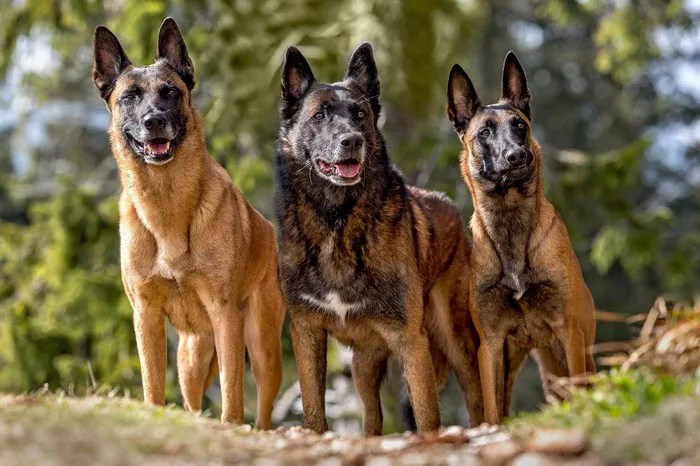Belgian Malinois dogs, often called “Malinois” or “Mals,” are celebrated for their intelligence, athleticism, and loyalty. However, their reputation as elite working dogs raises a critical question: Are they suitable for first-time dog owners? This article explores the breed’s unique needs, challenges, and rewards to help you make an informed decision.
Understanding the Belgian Malinois
Breed History and Traits
The Belgian Malinois originated in the city of Malines, Belgium, as a herding and guarding dog. Their agility, endurance, and sharp instincts made them indispensable for farm work and later for military and police roles. Today, they are widely used in bomb detection, search-and-rescue missions, and special operations, such as the 2011 raid that killed Osama bin Laden.
Physical Characteristics:
Size: Males stand 24–26 inches tall (61–66 cm) and weigh 55–75 lbs (25–34 kg); females are slightly smaller.
Coat: Short, weather-resistant fur with a dense undercoat, requiring minimal grooming but shedding seasonally.
Temperament:
Malinois are high-drive dogs with boundless energy. They thrive on mental and physical challenges and form intense bonds with their handlers. However, their sensitivity and strong protective instincts demand careful socialization.
Pros of Owning a Belgian Malinois
Unmatched Intelligence
A 2023 study ranked Belgian Malinois as the smartest dog breed, outperforming Border Collies and German Shepherds in problem-solving and understanding human gestures. This makes them quick learners in obedience, agility, or specialized tasks.
Loyalty and Versatility
Malinois are fiercely loyal and adaptable. They excel not only in work roles but also as therapy dogs or companions for active families—if their needs are met.
Health and Longevity
With a lifespan of 12–15 years and fewer genetic health issues than many large breeds, Malinois are relatively hardy.
Challenges for First-Time Owners
Extreme Energy Requirements
Malinois need 2+ hours of vigorous exercise daily, including running, agility training, or structured play. Without this, they may resort to destructive behaviors like chewing furniture or digging.
Example:
A bored Malinois might “herd” children by nipping at their heels, mimicking their instinctual livestock-guarding behavior.
Training Demands
While highly trainable, Malinois require consistent, experienced guidance. Novice owners often struggle with their stubbornness and sensitivity to harsh corrections. Positive reinforcement (treats, praise, toys) is essential.
Case Study:
Dog trainer Vinnie Somma warns that untrained Malinois can become liabilities due to unchecked protective instincts.
Socialization Needs
Early exposure to diverse environments, people, and animals is critical. Poor socialization can lead to aggression or anxiety. Puppy classes and controlled interactions are non-negotiable.
Time and Financial Commitment
Costs: Puppies from reputable breeders cost 4,000, while professional training can exceed $50,000.
Time: Their need for engagement makes them unsuitable for busy households or owners with limited free time.
Belgian Malinois vs. Other Breeds for First-Time Owners
German Shepherd
Pros: Slightly calmer, more adaptable to family life, and forgiving of training mistakes.
Cons: Prone to hip dysplasia and heavier shedding.
Golden Retriever
Pros: Gentle, eager to please, and low-maintenance. Ideal for families with children.
Cons: Less suited for high-intensity tasks.
Conclusion
For first-time owners, breeds like Golden Retrievers or Labradors offer a gentler introduction to dog ownership.
When a Belgian Malinois Might Work for You
Active Lifestyle
If you enjoy hiking, running, or dog sports and can dedicate 2–3 hours daily to your dog, a Malinois could be a rewarding partner.
Experience with High-Drive Dogs
Prior experience with working breeds (e.g., German Shepherds, Border Collies) helps. Malinois demand more intensity than most pets.
Access to Professional Training
Enrolling in obedience classes or hiring a trainer familiar with working dogs is highly recommended.
Alternatives to Buying a Puppy
Adoption
Rescue organizations often have adult Malinois needing homes. However, many require rehabilitation due to past trauma or neglect.
Foster-to-Adopt Programs
Fostering allows you to assess compatibility without long-term commitment. Some shelters provide training support.
Red Flags to Avoid
Impulse Buying
Movies like Channing Tatum’s Dog have spurred demand, leading to unprepared owners and abandoned dogs. Always research thoroughly.
Poorly Bred Puppies
Avoid breeders who prioritize looks over health or temperament. Ask for health clearances and meet the puppy’s parents.
Ignoring Behavioral Warnings
Signs like excessive barking, resource guarding, or fearfulness should be addressed immediately with a professional.
Final Checklist for Prospective Owners
- Before getting a Malinois, ask yourself:
- Can I provide 2+ hours of daily exercise?
- Do I have the budget for training and vet care?
- Am I prepared to socialize the dog extensively?
- Do I have experience with strong-willed breeds?
- If you answered “no” to any question, consider a less demanding breed.
Conclusion
The Belgian Malinois is not a “starter dog.” Their intelligence and energy make them exceptional partners for experienced handlers or active households, but they are a poor match for casual owners. First-time dog owners should opt for breeds with lower demands, such as Golden Retrievers or Labradors, unless they are fully committed to the Malinois’ rigorous lifestyle.
Related Topics:
THE ULTIMATE FEEDING GUIDE FOR BELGIAN SHEPHERDS
BELGIAN SHEPHERDS’ GROOMING GUIDE: TIPS FOR A HEALTHY AND WELL-MAINTAINED COAT
HOW TO TRAIN BELGIAN SHEPHERDS: A COMPREHENSIVE GUIDE TO PROFESSIONAL TRAINING


